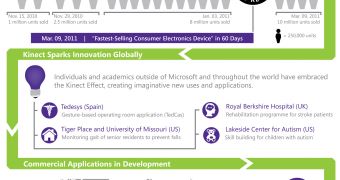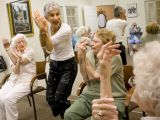Kinect is meant to offer a wider range of applications than playing video games, Microsoft claims, pointing out at the manner in which it could help people regain mobility after an accident.
When it comes to healthcare, Kinect can easily prove a successful solution for helping seniors, for example, through measuring the way people walk every day.
At the same time, it can be easily used for helping stroke patients regain movement, or for accessing necessary information without having to leave the operating room and sacrifice sterility.
Physical therapy is another area in which Kinect can prove of great help, and healthcare workers are also using it to help children with developmental disabilities or Attention Deficit Hyperactivity Disorder (ADHD).
“Honestly, what we know about here at Microsoft is but a tiny fraction of what is actually going on,” said Bill Crounse, a medical doctor and Microsoft’s senior director of worldwide health, referring to medical uses of Kinect.
“Everywhere I go in the world – every hospital, college or public health organization, people are already doing something with Kinect or they plan to.”
The Redmond-based software giant is keen on ensuring the emergence of new applications for Kinect, and has made available a software development kit for all those interested in delivering non-commercial projects to the world.
The company also aims at making available a similar SDK for those who would like to release commercial products.
For the time being, the company says it is quite happy with the manner in which people started using the sensor for healthcare applications.
Doctors at the Royal Berkshire Hospital in Reading, England, are making use of Kinect for Xbox 360 as part of rehabilitation for stroke patients. Different Kinect games could easily prove beneficial for patients, depending on the kind of rehabilitation they have to do.
Kinectimals, for example, a game in which wild cats respond to being petted, proved a great option for a patient who did not have much arm movement.
“The patient thought it was marvelous and we could actually see an improvement occurring, rather than the normal stretching and pulling a physiotherapist would do to the patient,” said Malcolm Sperrin, director of medical physics at the hospital.
The consumer version of Kinect proved great for these uses, but doctors are also interested finding ways to adapt it to specific needs, specifically in stroke rehabilitation.
The already created Kinect Effect is only a beginning, it seems, especially if healthcare is considered. Microsoft is deepening Kinect’s technology, and partners and researchers are looking into it as well.
“The Kinect effect barely describes it. It’s like the Kinect explosion,” Crounse said. “In my decade at Microsoft I have never seen anything that we are doing generate as much excitement in the consumer community, nor have I seen such excitement in the clinical and research communities as I have about Kinect and how this technology can be applied in health and healthcare.”

 14 DAY TRIAL //
14 DAY TRIAL // 
